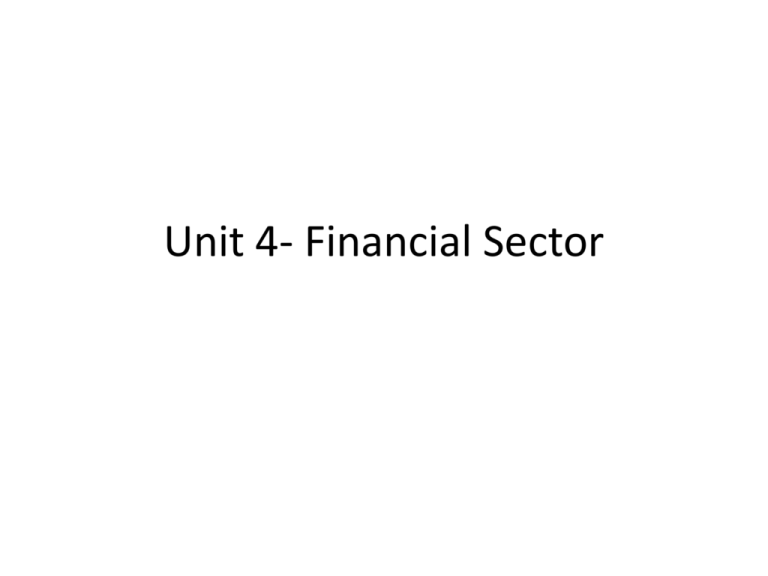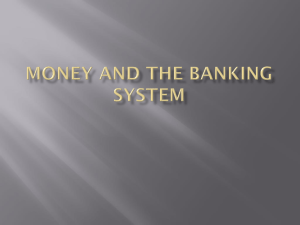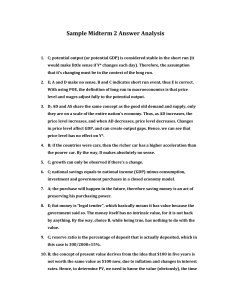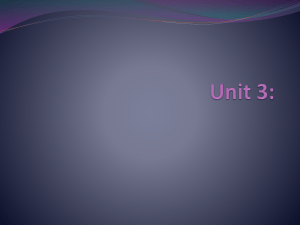
Unit 4- Financial Sector
Sam Simon
At the base of the pyramid on the $1 bill
you will find “****” in Roman Numerals
On the $100 bill, the clock tower of
Independence Hall in Philadelphia is
shown with the time set at 4:10.
According to the US Bureau of Engraving
and Printing, “there are no records
explaining why that particular time was
chosen”
The elm tree on back of the $20 bill near
the White House represents a real tree
in this same location. However, the tree
is no longer on the White House grounds
because it succumbed to rain-softened
ground in 2006
Most people save $2 bills, thinking they
are rare and therefore valuable; they're
actually worth... $2
97% of all paper money contains
traces of cocaine
Barter
• Inefficient
• Prevents economic growth
• Double coincidence of wants
Types of Money
Commodity money- money itself serves a
purpose (i.e. tulip bulbs, salt, tobacco)
Commodity-Backed money- money’s value is
backed by a commodity (gold, silver)
*Fiat money- value based solely on acceptance
of value and government backing
Functions of Money
• Medium of Exchange
• Unit of Account (Standard of Value)
• Store of Value
Time Value of Money
Money and Interest Rates
• PV=FV/(1+r)n
• FV = PV X (1+r)n
13% interest rate
I give you $100 today
I give you $100 on March 10, 2016
*No calculators on the AP exam, so…
Money Supply
Measures based on Liquidity
• Monetary Base =
• M0 =
• M1=
• M2=
The Banking System
– Three important features of the fractional reserve
banking system:
• Bank profitability
• Banks discretion over the money supply
• Exposure to bank runs
The Banking System
• Principles of Bank Management: Profits versus
Safety
– Greater risk – greater potential profit.
– How much risk to take??
– How’s that worked out?
FIGURE 28-1 Bank Failures in the United
States, 1915-2000
2,200
FDIC established
1,800
1,600
1,400
1,200
1,000
800
Number of Bank Failures
Number of Bank Failures
2,000
200
160
120
80
40
0
1935
1945
1955
1965
1975
1985
'95 '00
600
400
Great Depression begins
200
0
1915 1920 1925 1930 1935 1940 1945 1950 1955 1960 1965 1970 1975 1980 1985 1990
Year
'95
'00
Copyright © 2003 South-Western/Thomson Learning. All rights reserved.
The Banking System
• Bank Regulation
– Deposit Insurance
• The Federal Deposit Insurance Corporation insures
people’s deposits at banks.
– Bank Supervision
• Ensures banks take only sensible, defensible risks
• Controls the money supply
– Reserve Requirements
• Helps control the money supply
Multiplier Effect
• Simple Deposit Multiplier = 1 /Reserve Requirement
• RR = 10%
• Multiplier =
Money Supply Expansion
• Expansion = Multiplier X Excess Reserves
• For each calculate expansion for a $1000
deposit.
How Bankers Keep Books
Banks keep balance sheets
Assets = liabilities + net worth (Equity)
Assets include:
Reserves
Loans
Liabilities include:
Deposits owed to customers.
Money Market
Money Market
• Q of money is fixed at any given point in time
• MS = M1
Money Market
• i = nominal interest rate
• Money Market graphs short term interest rates
Money Market
• Nominal Interest rate is the Federal Funds Rate
• FFR = rate banks charge each other for
overnight loans
Money Market
• MD= Q of money demanded at various interest
rates
• Q of money demanded = amount of wealth held as
money over other assets
Money Market
• What is the opportunity cost of holding money?
Money Market
• Money v. Bonds
Money Market
• Change in “i“ causes movement along the curve
Money Market
• Increase in RGDP and Price Level will shift MD to
the right
Fed Tools
• Open Market Operations- buy/sell bonds
• Discount Rate- rate Fed charges banks
• Reserve Requirement/Required Reserve Ratio
What should the Fed do?
• During a recessionary period? List 3
• During an inflationary period? List 3
What should the Fed do?
• During a recessionary period?
– Expansionary Monetary Policy
• During an expansionary period?
– Contractionary Monetary Policy
Agenda
• FRQ Review
– Bond Basics
– Bond prices
• Balance Sheets
– Intro and Practice
• HW- Real v. Nominal Article
• Test- Friday???? Or Monday
Just what is a bond?
•
•
•
•
•
•
•
•
Issued by a government or business to raise $
Bond purchaser is the lender
Purchaser receives regular interest payments
Interest rate is called coupon rate
Purchaser is paid the principle at maturity
Longer the term, higher the interest
Bonds can be traded before maturity
Privately issued bonds have higher coupon
rates- more risk
• US government bonds have “zero” risk
Agenda
• Balance Sheet FRQs
• Money Demand Dissected
• Equation of Exchange Intro
• Sides Game
Stock v. Bonds
• Stock = owner
• Bond = lender
– Riskier company = higher coupon rate
Trading Existing Bonds
• If interest rates go up?
• If interest rates go down?
How Bankers Keep Books
Banks keep balance sheets
Assets = liabilities + net worth (Equity)
Assets include:
Reserves
Loans
Liabilities include:
Deposits owed to customers.
Balance Sheets- Important Points
1. Deposits and withdraws do not INITIALLY change M1
2. Required Reserves only apply to demand (checkable) deposits
Demand for Money
• Transaction Demand- function?
• Asset Demand- function?
Demand for Money
• Financial Assets- stocks, bonds, loans, deposits
• Asset Demand- inverse relationship to interest rates
Monetarism
• Money Supply is chief determinant of
economic growth
• MV = PQ
MV = PQ
• Equation of exchange
•
•
•
•
M= money supply
V= velocity of money
P= price level
Q= quantity of goods and services produced
MV = PQ
• Equation of exchange
• V = constant
• Increase in M should outpace increase in Q
• Otherwise- “Too much money chasing too few
goods”
MV = PQ
• Otherwise- “Too much money chasing too few
goods”
Sides Game
Investment Demand
Investment Demand
• Investment leads to capital formation
• This changes future capital stock
• This influences growth rate
Investment Demand
• Some Determinants
– Expectations
– Capacity Utilization
– Cost of Capital Goods
– Tax Credits












